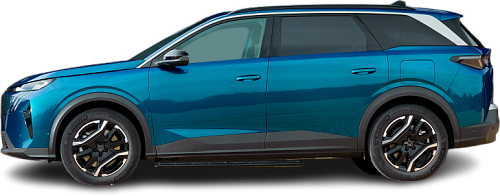Global EV Comparison: Peugeot e-5008 73 kWh AWD vs Hyundai Ioniq 5 XRT
Struggling to Decide? Let AI Help!
Your AI Summary Is Ready!
General Info
While the Hyundai Ioniq 5 XRT (2025-...) is currently produced, it is not offered for sale in Europe. The Peugeot e-5008 73 kWh Dual Motor AWD (2025-…) is announced, but not yet in production.
The two vehicles share the same body style: SUV.
| Property | Peugeot e-5008 73 kWh AWD | Hyundai Ioniq 5 XRT |
|---|---|---|
| Years of Production | 2025-… | 2025-… |
| Current Status | Announced | Produced |
| Country of Manufacture | France | Indonesia, Singapore, South Korea |
| Body Style | SUV | SUV |
| Market Availability | EU | USA |
| Price Europe (New) | €55000 | - Price Europe (New) |
| GCC Score | 6.9 | 6.6 |
Range and Efficiency
Even though the Hyundai Ioniq 5 XRT (2025-...) has a larger battery, the Peugeot e-5008 73 kWh Dual Motor AWD (2025-…) higher energy efficiency results in a longer real-world driving range.
| Property | Peugeot e-5008 73 kWh AWD | Hyundai Ioniq 5 XRT |
|---|---|---|
| Range (EPA) | - Range (EPA) | 417 km |
| Range (WLTP) | 500 km | - Range (WLTP) |
| Range (GCC) | 425 km | 396 km |
| Battery Capacity (Nominal) | 77 kWh | 84 kWh |
| Battery Capacity (Usable) | 73 kWh | 80 kWh |
| Efficiency per 100 km | 17.2 kWh/100 km | 20.2 kWh/100 km |
| Efficiency per kWh | 5.82 km/kWh | 4.95 km/kWh |
| Range and Efficiency Score | 7.4 | 6.1 |
Charging
The Hyundai Ioniq 5 XRT (2025-...) features an advanced 800-volt architecture, whereas the Peugeot e-5008 73 kWh Dual Motor AWD (2025-…) relies on a standard 400-volt system.
The Hyundai Ioniq 5 XRT (2025-...) offers faster charging speeds at DC stations, reaching up to 250 kW, while the Peugeot e-5008 73 kWh Dual Motor AWD (2025-…) maxes out at 160 kW.
Both vehicles are equipped with the same on-board charger, supporting a maximum AC charging power of 11 kW.
| Property | Peugeot e-5008 73 kWh AWD | Hyundai Ioniq 5 XRT |
|---|---|---|
| Max Charging Power (AC) | 11 kW | 11 kW |
| Max Charging Power (DC) | 160 kW | 250 kW |
| Architecture | 400 V | 800 V |
| Charge Port | CCS Type 2 | CCS Type 2 |
| Charging Score | 6.5 | 7.9 |
Performance
Both vehicles are all-wheel drive.
Although the Peugeot e-5008 73 kWh Dual Motor AWD (2025-…) has more power, the Hyundai Ioniq 5 XRT (2025-...) achieves a faster 0-100 km/h time.
| Property | Peugeot e-5008 73 kWh AWD | Hyundai Ioniq 5 XRT |
|---|---|---|
| Drive Type | AWD | AWD |
| Motor Type | PMSM (front), PMSM (rear) | PMSM (front), PMSM (rear) |
| Motor Power (kW) | 240 kW | 239 kW |
| Motor Power (hp) | 322 hp | 320 hp |
| Motor Torque | 511 Nm | 605 Nm |
| 0-100 km/h | 6 s | 5.2 s |
| Top Speed | 170 km/h | 185 km/h |
| Performance Score | 4.7 | 5.2 |
Dimensions
The Peugeot e-5008 73 kWh Dual Motor AWD (2025-…) is longer and taller, but about the same width as the Hyundai Ioniq 5 XRT (2025-...).
The Hyundai Ioniq 5 XRT (2025-...) boasts a more extended wheelbase.
| Property | Peugeot e-5008 73 kWh AWD | Hyundai Ioniq 5 XRT |
|---|---|---|
| Length | 4791 mm | 4655 mm |
| Width (with Mirrors) | 2108 mm | 2152 mm |
| Width (w/o Mirrors) | 1895 mm | 1890 mm |
| Height | 1694 mm | 1625 mm |
| Wheelbase | 2901 mm | 3000 mm |
Cargo and Towing
The Peugeot e-5008 73 kWh Dual Motor AWD (2025-…) provides more cargo capacity, featuring both a larger trunk and more space with the rear seats folded.
A frunk (front trunk) is available in the Hyundai Ioniq 5 XRT (2025-...), but the Peugeot e-5008 73 kWh Dual Motor AWD (2025-…) doesn’t have one.
Neither vehicle is officially rated for towing in in the EU.
| Property | Peugeot e-5008 73 kWh AWD | Hyundai Ioniq 5 XRT |
|---|---|---|
| Number of Seats | 7 | 5 |
| Curb Weight | 2300 kg | 2135 kg |
| Cargo Volume (Trunk) | 738 l | 520 l |
| Cargo Volume (Max) | 1815 l | 1580 l |
| Cargo Volume (Frunk) | - Cargo Volume (Frunk) | 24 l |
| Cargo and Towing Score | 7.4 | 6.8 |




